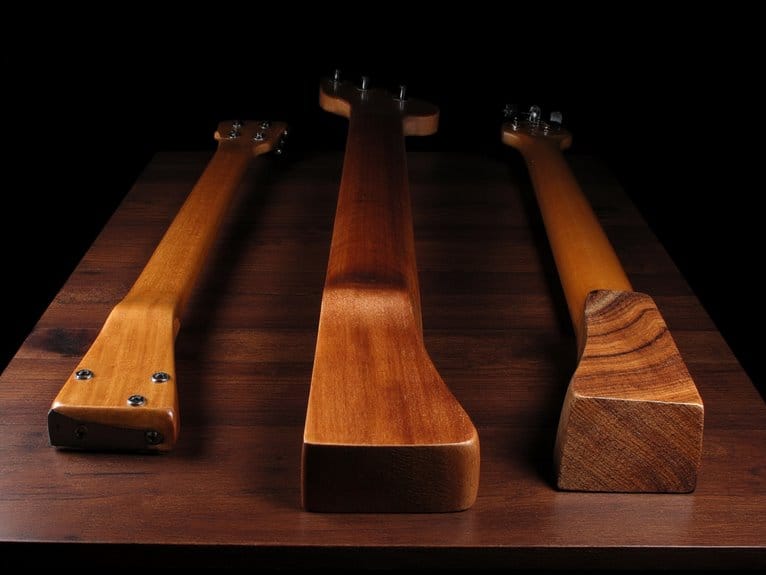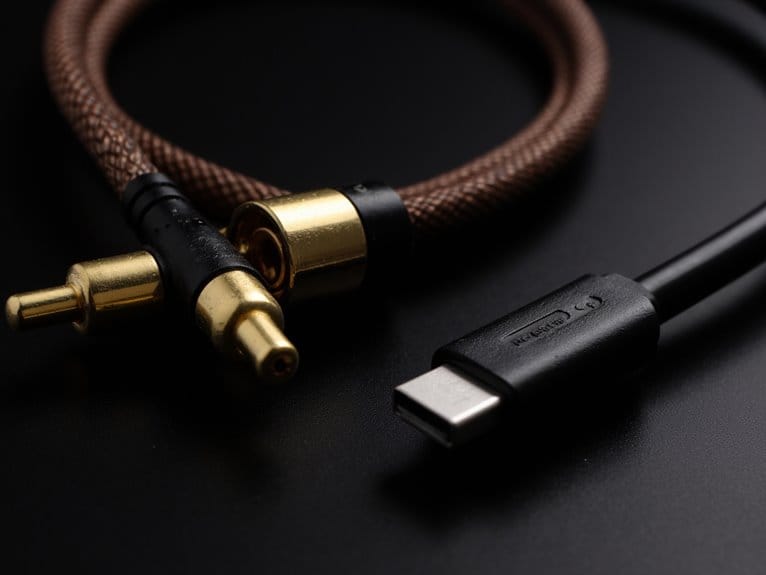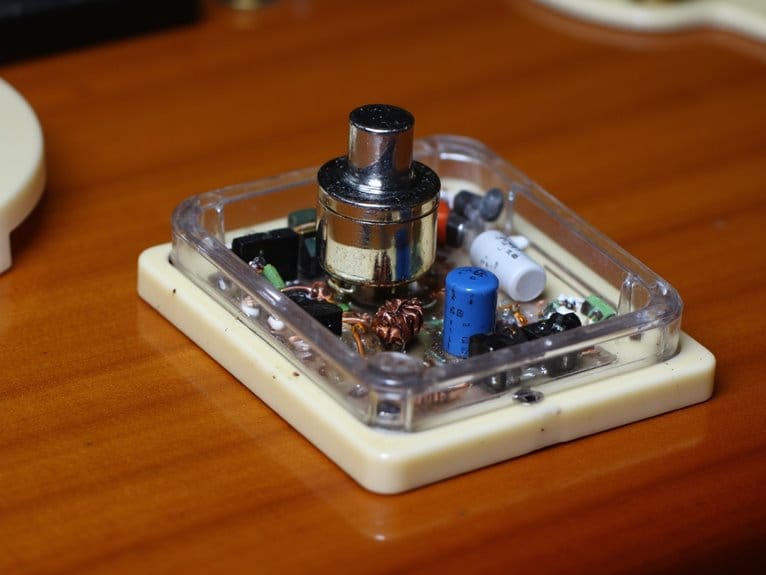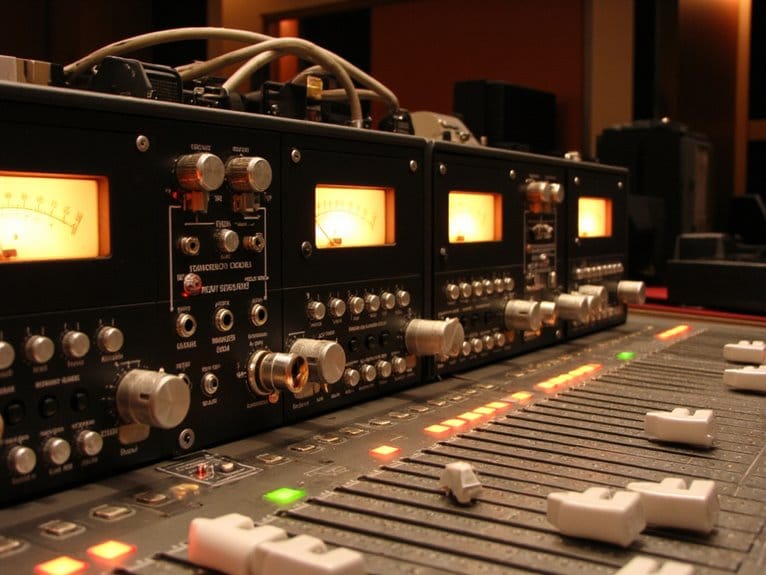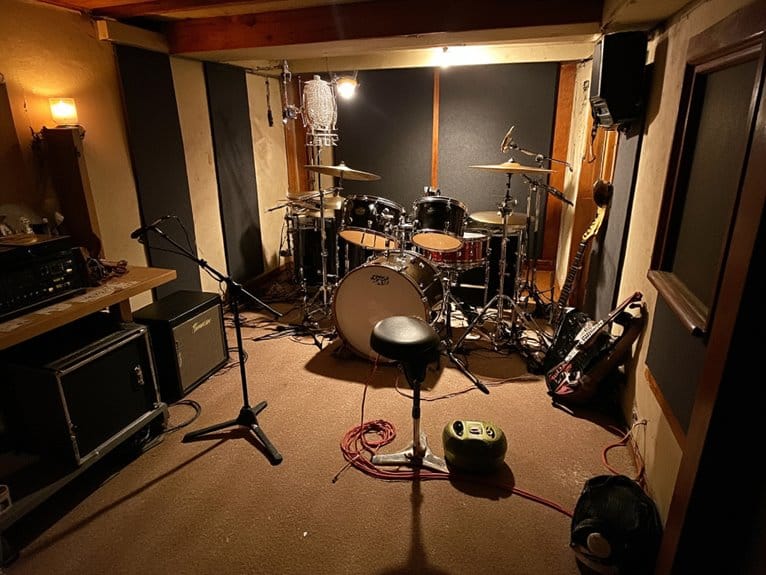Understanding Guitar Neck Construction: Bolt-On Vs Set-In Vs Neck-Through
Guitar necks attach to bodies through three primary methods that considerably affect your instrument’s sound and feel. Bolt-on necks use screws for bright, articulate tones with easy maintenance but limited sustain—perfect for funk and country styles. Set-in necks employ permanent glued joints, delivering enhanced sustain and midrange warmth ideal for blues and jazz. Neck-through designs offer maximum sustain and seamless upper fret access but cost considerably more. Understanding these differences will help you choose the construction method that matches your playing style and discover the technical nuances behind each approach.
We are supported by our audience. When you purchase through links on our site, we may earn an affiliate commission, at no extra cost for you. Learn more.
Notable Insights
- Bolt-on necks use screws for attachment, producing bright articulate tones with quick response, ideal for funk and country genres.
- Set-in necks utilize permanent glued joints, delivering enhanced sustain and midrange richness perfect for blues and jazz styles.
- Neck-through construction offers maximum sustain and seamless fret access but comes with higher costs and repair difficulties.
- Bolt-on necks provide easiest maintenance and lowest cost, while set-in and neck-through require more skilled craftsmanship.
- Upper fret accessibility varies significantly: bolt-on necks have heel restrictions, while neck-through designs offer completely unobstructed access.
The Three Primary Neck Attachment Methods
The world of guitar construction revolves around three fundamental neck attachment methods, each offering distinct tonal characteristics, structural benefits, and manufacturing considerations that I’ve observed throughout my years examining instruments.
You’ll encounter bolt-on necks, which secure through screws or bolts, providing easy maintenance and bright tones.
Set-in necks utilize mortise-and-tenon or dovetail joints with glue, delivering warmer sounds and enhanced resonance while maintaining excellent joint integrity.
Neck-through construction extends the neck through the entire body length, maximizing sustain and stability. This method traces back to 1956 with Rickenbacker as one of the first manufacturers to implement this innovative design approach.
Each method affects neck angle differently, influencing playability and string action. The neck profile can vary significantly between construction methods, with slimmer C-shaped designs often enhancing comfort and reducing hand span requirements during play.
Similar to how different woods like Baltic birch enhance acoustic properties in cajons, the wood choice in guitar neck construction significantly impacts the instrument’s tonal characteristics and resonance. Many beginner guitarists find that guitars with slim neck profiles reduce hand fatigue during practice sessions, making the learning process more comfortable and enjoyable.
I’ve found that your choice depends on tonal preferences, maintenance requirements, and playing style, with each approach offering unique advantages for different musical applications. Set-in neck guitars require steaming or melting the glue for any repairs, making maintenance more complex than other construction methods.
Bolt-On Neck Construction and Characteristics
When you’re examining bolt-on neck guitars, you’ll notice they use mechanical fasteners—typically four or five screws rather than actual bolts—that anchor through a visible metal plate on the guitar’s back, creating the most economical manufacturing approach in the industry.
I’ve found that this separate construction method allows manufacturers to produce necks and bodies independently, greatly reducing production costs while maintaining quality control standards that benefit both budget-conscious players and large-scale operations. The neck must fit snugly into the body’s neck pocket to ensure proper alignment and optimal resonance transfer.
You can expect bolt-on necks to deliver that characteristic bright, articulate attack with pronounced note definition, though you’ll sacrifice some sustain compared to glued-joint alternatives due to the mechanical connection interrupting vibration transfer between components.
Mechanical Fastener Assembly Method
While I’ve spent countless hours examining different neck attachment methods, bolt-on construction remains one of the most practical and versatile approaches you’ll encounter in guitar manufacturing.
The mechanical fastener assembly relies on precise drilling and alignment, where fastener types typically include four screws or heavy-duty machine bolts with embedded tee-nuts for enhanced durability.
Key assembly techniques include:
- Precise hole drilling – Exact positioning prevents vibration dampening and misalignment
- Heel plate installation – Distributes bolt pressure and protects wood integrity
- Pocket alignment – Guarantees proper string action and bridge positioning
- Tee-nut embedding – Prevents screw hole stripping during repeated assembly
This modularity allows separate manufacturing and finishing, though you’ll notice the mechanical interface creates that distinctive “snappy” tone characteristic of bolt-on guitars.
Many beginner electric guitars utilize bolt-on neck construction because it offers cost-effective manufacturing while maintaining reliable structural integrity and ease of maintenance. The components typically feature Canadian maple construction for enhanced stability and reliable performance across different playing styles.
The choice of string gauge can significantly impact how the bolt-on neck responds to tension and affects overall playability and tone production.
Cost-Effective Manufacturing Benefits
Throughout my decades of observing guitar manufacturing trends, I’ve consistently found that bolt-on neck construction delivers the most compelling cost advantages in modern instrument production, primarily because it transforms complex woodworking into straightforward assembly-line processes.
You’ll notice that major manufacturers like Fender and Yamaha embrace this method for good reason—it enables parallel production lines where necks and bodies develop simultaneously, dramatically improving cost efficiency through reduced labor requirements and simplified quality control procedures.
The modularity truly shines when you consider production scalability, as defective components get swapped rather than scrapped, minimizing waste while maximizing throughput.
I’ve observed that this approach eliminates expensive gluing stages, specialized joint-fitting skills, and lengthy curing times, allowing manufacturers to offer competitive pricing across entry-level to premium instruments without sacrificing build quality. Just as amplifier manufacturers leverage power attenuation features to maintain tube saturation while reducing costs, guitar makers use bolt-on construction to preserve quality while streamlining production.
This cost-effective approach particularly benefits acoustic guitars, where manufacturers can utilize all-laminate construction to create durable instruments at accessible price points while maintaining consistent quality standards.
Similarly to how wireless microphone systems enable modular audio setups where transmitters and receivers can be independently replaced or upgraded, bolt-on construction provides manufacturers with flexible component management that reduces overall production costs.
Tonal Attack Characteristics
Beyond the manufacturing advantages I’ve covered, bolt-on neck construction produces distinctly different tonal characteristics that I’ve found can make or break a guitar’s suitability for specific musical styles.
The mechanical joint between neck and body creates what I consider the hallmark “snap” that defines classic Telecaster twang and Stratocaster bell-like articulation, delivering superior attack dynamics through enhanced note definition.
Here’s what makes bolt-on necks tonally distinctive:
- Sharper Attack Response – Notes hit with more “pop” and immediate clarity
- Enhanced Tonal Clarity – Complex chord work benefits from quicker note decay
- Brighter Overall Character – Maple necks amplify the naturally bright qualities
- Reduced Sustain Trade-off – Less resonance transfer means shorter natural ring-out
This construction style particularly excels in country, funk, and rhythm-focused rock where articulate, punchy tones matter more than endless sustain. The neck profile directly impacts playability comfort, with C-shaped designs offering the most universally appealing feel for players across different genres.
When pairing with amplifiers, these bright, articulate characteristics work exceptionally well with solid-state amps that provide clean power and precise tone reproduction without adding unwanted coloration. For practice purposes, the clarity of bolt-on necks pairs beautifully with 10-watt amplifiers that maintain sound integrity while providing both clean tones and overdrive for exploring different tonal textures.
Set-In Neck Design and Performance
When you’re exploring premium guitar construction, you’ll encounter set-in necks, which represent a more traditional approach where the neck and body are permanently joined using a precisely cut dovetail joint and strong wood glue.
This glued connection creates exceptional sustain and tonal transfer that makes your notes ring longer and fuller, which explains why guitarists often describe set-in neck instruments as having warmer, thicker sound characteristics.
You’ll find this construction method chiefly in high-end guitars from manufacturers like Gibson and PRS, where the additional craftsmanship costs are justified by the superior resonance and structural integrity. The enhanced sustain capabilities of set-in necks mean your notes will maintain their brightness and tonal qualities for extended periods compared to other construction methods.
Many hollow body guitars also utilize set-in neck construction, with instruments like those featuring mahogany necks delivering the enhanced sustain and resonance that complement the natural acoustic properties of the hollow chamber. The solid spruce top contributes significantly to the overall tonal quality and sound projection of these instruments.
Glued Joint Construction Method
While bolt-on necks dominate the production guitar market for their simplicity, I’ve found that set-in neck construction represents a more sophisticated approach that fundamentally changes how the instrument functions as a unified system. The glue penetration creates molecular bonds within wood fibers, effectively welding components together rather than merely sticking surfaces.
This joint geometry, typically featuring dovetail or mortise-and-tenon configurations, demands precision craftsmanship that I’ve witnessed destroying many apprentice luthiers’ confidence.
The construction process involves four critical elements:
- Surface preparation requiring perfectly matched angles and contact points
- Specialized adhesives that cure slowly, allowing proper alignment during assembly
- Clamping systems maintaining pressure while avoiding joint displacement
- Temperature control ensuring ideal curing conditions for maximum strength
Sustain and Tone Transfer
The molecular bonds I’ve described fundamentally alter how vibrational energy moves through your guitar, creating what I consider the most misunderstood aspect of set-in neck performance.
You’ll experience enhanced tone transfer efficiency through the dovetail joint’s seamless connection, which minimizes energy loss while delivering warmer, fuller sound characteristics.
However, sustain perception often contradicts scientific evidence—controlled studies reveal bolt-on necks actually sustaining equal or longer than set-ins, despite conventional wisdom suggesting otherwise.
The tonal nuances you hear stem from how set necks blur attack transients, creating that perceived “fullness” rather than measurable sustain improvements. These characteristics also apply to bass guitars, where split-coil pickups combined with quality neck construction deliver the warm, versatile tones essential for learning fundamental techniques.
Your guitar’s intimate glued connection distributes string energy more evenly, fattening note body and enhancing resonance, though these differences remain subtle and context-dependent.
While neck construction significantly affects sustain and tone transfer, features like scalloped bracing patterns can also enhance bass response and overall sound depth in acoustic instruments. Similarly, recording these tonal nuances requires quality equipment, and many affordable audio interfaces now provide professional-grade preamps that can accurately capture these subtle guitar tonal characteristics.
High-End Guitar Applications
Although countless guitarists debate construction methods endlessly, I’ve found that high-end applications reveal set-in necks at their absolute finest—where premium materials, meticulous craftsmanship, and luxury aesthetics converge to justify the added complexity.
When you’re investing in premium models, you’ll discover why vintage craftsmanship principles still dominate Custom Shop offerings from Gibson and PRS. The tonal richness achieved through precise dovetail joints and quality mahogany creates that coveted warmth I’ve heard in countless studios.
Here’s what sets high-end set-neck guitars apart:
- Design aesthetics: Seamless body-to-neck joints create visual elegance
- Luthier expertise: Master craftsmen guarantee peak resonance through precision fitting
- Ergonomic benefits: Refined heel designs improve upper fret access
- Material selection: Premium tonewoods enhance vibrational coupling
You’ll find these construction techniques particularly valuable in rock and metal applications, where sustain and harmonic complexity matter most. Set-neck designs enhance resonance and sustain compared to bolt-on construction, making them the preferred choice for players seeking maximum tonal transfer. While set-neck designs dominate premium guitars, C-shaped neck profiles have become increasingly popular across various construction methods for their enhanced comfort and control during extended playing sessions.
Neck-Through Construction Benefits and Drawbacks
When you’re considering a neck-through guitar, you’ll encounter what I’d call the ultimate trade-off in guitar construction—a design that offers exceptional playability and structural integrity, but comes with considerable cost and maintenance considerations that might make you think twice.
The benefits are compelling: seamless access to higher frets, enhanced stability, and superior durability that’ll withstand environmental changes better than bolt-on alternatives.
Neck-through construction delivers unmatched fret access and stability that outperforms traditional bolt-on designs in challenging environments.
You’ll experience consistent feel along the neck’s length, making technical playing smoother and reducing hand fatigue during complex performances.
However, durability concerns emerge when damage occurs, as repair difficulties make neck-through guitars notoriously expensive to fix.
The intricate multi-ply construction increases manufacturing costs considerably, typically reserving these instruments for higher-end models where the enhanced playability justifies the premium price.
Tonal Differences Between Construction Types
Beyond the structural differences we’ve explored, what truly separates these construction methods lies in their distinct sonic signatures—each imparting characteristic tonal qualities that’ll fundamentally shape your guitar’s voice and musical expression.
The tonal evolution from bolt-on to set-in to neck-through represents a progression from bright attack to sustained warmth.
Bolt-on necks deliver that signature Fender snap—quick, percussive response perfect for funk and country’s articulation demands.
Set-in construction offers midrange richness and harmonic complexity, favoring blues and jazz applications.
Neck-through designs maximize sustain while maintaining clarity.
Your genre preferences should guide this choice:
- Bolt-on: Country, funk, classic rock requiring sharp attack
- Set-in: Blues, jazz needing warmth and sustain balance
- Neck-through: Progressive rock, metal demanding maximum sustain
- Wood selection: Maple brightens, mahogany warms regardless of construction
Playability and Upper Fret Access Considerations
While tonal characteristics often dominate our purchasing decisions, I’ve learned that playability—particularly your ability to navigate those upper frets comfortably—can make or break your relationship with an instrument.
Bolt-on necks present the greatest challenge for upper fret accessibility, as their pronounced heel and mounting plate create physical obstructions that limit hand movement beyond the 15th fret.
Set-in necks offer a middle ground, utilizing smaller glued joints that allow better contouring and smoother shifts, though they can’t match neck-through designs.
Set-in necks provide improved upper fret access through better contouring, but still fall short of neck-through construction’s seamless playability.
Neck-through construction eliminates the heel entirely, providing seamless access to every fret without obstruction.
These playability factors become essential when you’re attempting complex solos or technical passages that demand unrestricted movement across the entire fretboard.
Wood Selection and Manufacturing Techniques
The foundation of every great guitar neck begins with wood selection, and I’ve discovered that choosing the right species involves balancing tonal characteristics, structural stability, and manufacturing considerations that directly impact your instrument’s performance and longevity.
Understanding wood properties becomes essential when you’re evaluating different species. Mahogany offers warm tones with excellent stability, while maple provides brightness but requires reinforcement to prevent warping. Dense woods like ebony deliver superior sustain but add weight, whereas lighter options like Spanish cedar suit classical applications.
Key manufacturing techniques that optimize neck performance include:
- Quarter-sawing timber to align grain direction vertically for maximum stability
- Carbon fiber reinforcement in maple necks to prevent twisting without weight penalties
- Laminated construction combining multiple wood layers for strength and aesthetics
- Precise milling of neck blanks with specific grain patterns for visual appeal
Frequently Asked Questions
Which Neck Construction Is Best for Beginner Guitar Players?
You’ll find bolt-on necks best match beginner preferences due to their affordability and durability. These neck advantages include easy maintenance, bright tone versatility, and simple repairs, making them ideal for learning without major investment concerns.
How Long Does Each Neck Construction Type Typically Last Before Needing Repair?
When considering neck repair longevity, you’ll find bolt-on necks typically last 20+ years, set-in necks 30+ years, and neck-through constructions 40+ years. Construction durability comparisons show neck-through designs offer superior long-term stability.
On a final note
You’ll find that each neck construction method offers distinct advantages, and honestly, there’s no universally “best” choice. Your playing style, musical preferences, and budget should guide your decision. While I’ve seen players obsess over tonal differences, the reality is that your amp, pickups, and technique matter more than most folks realize. Don’t overthink it—focus on how the guitar feels in your hands and sounds through your rig.

